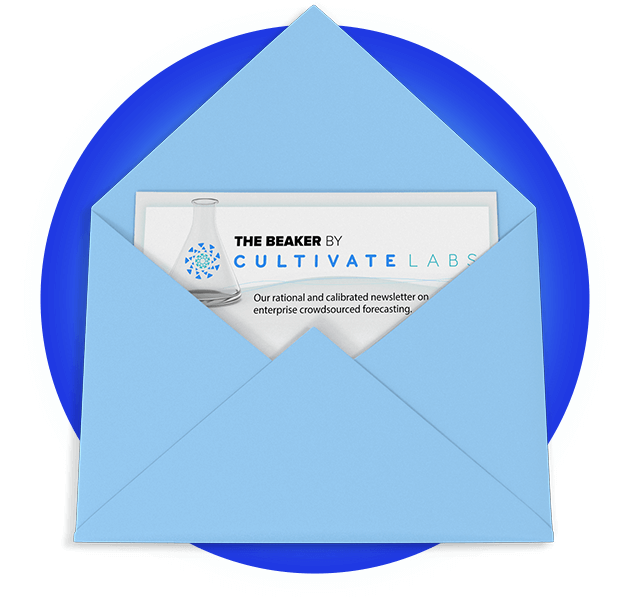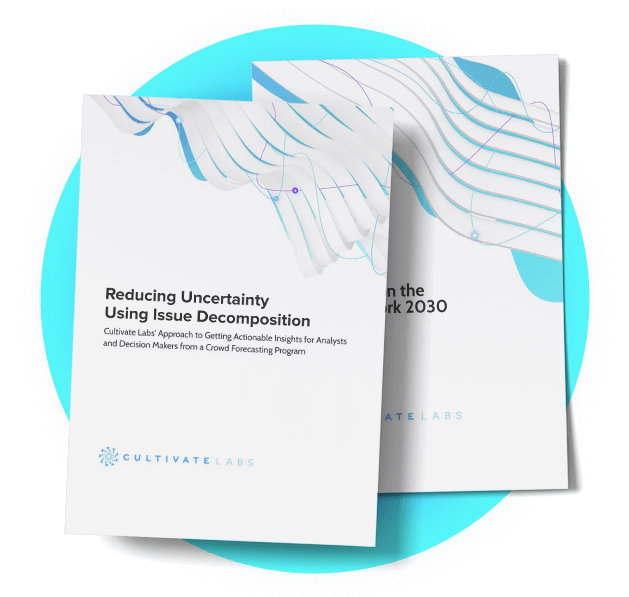Cultivate Labs Blog
Discussing how crowd forecasting, internal crowdfunding, and other new workplace trends can be used to improve the #futureofwork

Sign Up For Our Monthly Newsletter
By Adam Siegel on Jun 05, 2025
A few reflections on my time visiting Kyiv
Last month I had the opportunity to travel to Kyiv for some work we’re doing there. Since not many people are traveling to Kyiv these days from the US, I thought I would share a few reflections on my visit.
Read moreBy Adam Siegel on Dec 19, 2024
2024 End of Year Retrospective
Before we close shop and take a few days off, I wanted to take a moment to reflect on the challenges, milestones, and relevant events that defined the year for our company + a few extra musings if you will so indulge me. So let’s take a step back and reflect on what made this year what it was.
Read moreBy Adam Siegel on Nov 17, 2024
Cultivate Labs Awarded As a Supplier on UK Crown Commercial Service's G-Cloud 14 Framework
After a detailed vetting process earlier this year, Cultivate Labs has been awarded as a supplier on Crown Commercial Service’s (CCS) G-Cloud 14 framework. This means any UK Government agency or UK non-profit or charity can easily access Cultivate's cloud hosted software and professional services.
Read moreBy Adam Siegel on Oct 15, 2024
Introducing un-scored questions
The religion of probabilistic forecasting says SCORE EVERYTHING and we try to(!), but there are times when you want to ask a question that may not have good resolution criteria or the answer is 5+ years from being known so we've introduced unscored questions.
Read moreBy Cultivate Labs on Aug 28, 2024
Expert Q&A: Advancing wildfire predictions to protect Canada's forests
The Canadian Forest Service utilizes crowd forecasting program called Firesight to predict wildfire occurrences and damages across Canadian regions. We sat down with Forest Fire Research Scientist Mike Wotton to learn more about how Firesight is supporting the fire management community.
Read moreBy Vanessa Pineda on Apr 03, 2024
Teaching future government leaders how to assess policy decisions using decomposition
Georgetown graduate students participate in a Cultivate decomposition workshop to learn how policy analysts break down an issue such as the Israel-Hamas War - and combine it with crowd forecasting to track future outcomes.
Read moreBy Cultivate Labs on Mar 04, 2024
How crowdsourced forecasting works
Crowdsourced forecasting is the process of soliciting quantitative forecasts (e.g. probabilities) about future events from a large group of people, then aggregating them into a "crowd" forecast. By harnessing the collective intelligence of a large, diverse group of people, crowd forecasting gives an analyst or decision maker valuable outside perspectives to consider.
Read moreBy Cultivate Labs on Mar 04, 2024
The value of crowd forecasting for government and industry
Cultivate supports government national security communities and multinational organizations in implementing crowdsourced forecasting. This methodology builds a cycle of information, in which experts can tap into the collective intelligence of their organization to bolster decision analysis.
Read moreBy Vanessa Pineda on Feb 26, 2024
Citations enhance AI-generated rationale summaries on our Forecasts platform
Our AI forecast rationale summaries have been updated to include citations, so you can see the original context of the forecast and rationale contributed.
Read moreBy Faith Powell on Dec 05, 2023
Turning to crowdsourced forecasting when you’re not sure who or what to listen to
With the rise of AI, disinformation in mass media will only continue to grow and evolve. Turning our attention to crowd forecasting is one way that we can better understand, monitor, and respond to global uncertainty – together.
Read moreBy Vanessa Pineda on Nov 06, 2023
New whitepaper: A roadmap for using AI in crowdsourced forecasting
New whitepaper explores how to use AI across different aspects of crowdsourced forecasting, including question development, reporting, engagement, and forecasting.
Read moreBy Faith Powell on Nov 03, 2023
Cultivate Forecasts platform now features AI-generated forecast rationale summaries
We released a new feature on our forecasting platform: AI-powered forecast rationale summaries using Anthropic’s Claude2. Read about how forecasters and analysts are already using this capability.
Read moreBy Faith Powell on Oct 05, 2023
Team forecasting lessons from Cultivate Labs
As a company, we hold small group forecasting sessions regularly. We’ve learned a few tactics to help other teams surface diverse viewpoints and avoid groupthink. Here are some recommendations for any teams forecasting together.
Read moreBy Faith Powell on Oct 02, 2023
Google experts join a forecasting meetup about the future of AI hosted by Cultivate’s INFER
Earlier this month, one of our client programs INFER – the crowd forecasting program supporting the U.S. Government – hosted a special forecasting event about the future of AI. The event was attended by select INFER forecasters and nearly two dozen forecasting enthusiasts who work at Google, joining in a personal capacity.
Read moreBy Adam Siegel on Aug 22, 2023
Announcing a new service: Issue Decomposition Workshops
We are launching a service offering: "issue decomposition" workshops – a new way of methodically understanding how the future will impact your most important decisions and policies.
Read moreBy Faith Powell on Jul 11, 2023
New capability makes it easy to collect forecasts from wider audiences
Cultivate has released a new “request for response” capability that allows you to send any audience a simple survey, in which they can submit forecasts that will automatically get aggregated with your crowd’s on your Forecasts platform.
Read moreBy Cultivate Labs on Jun 29, 2023
Q&A with Cultivate: A look into our forecast question development process
One of the first steps in a crowdsourced forecasting effort involves establishing a process for developing forecast questions that will deliver meaningful signals to decision-makers. We wanted to shed some light on our process, so we talked to a few of our team members that focus on developing questions for our client platforms.
Read moreBy Faith Powell on Jun 05, 2023
Our new forecast question interface for yes/no binary questions
We recently launched an update to our binary question interface – it will now show both “yes” and “no” answer options, rather than a single “yes” option. When you change the probability for one answer, the other will automatically update to ensure the probabilities always add to 100%.
Read moreBy Cultivate Labs on May 10, 2023
Introducing the INFER mobile app
Our forecasters have been asking for a mobile app – and we are excited to share that it is now available for INFER, a crowd forecasting program in partnership with the University of Maryland’s ARLIS to support U.S. Government policymakers. You will now be able to submit forecasts on critical questions to support INFER’s government stakeholders directly from our native app on a phone or tablet.
Read moreBy Ben Roesch on May 05, 2023
Does forecasting accuracy really matter?
tl;dr - Yes, of course it matters. But improving it in lieu of the other benefits crowdsourced forecasting can provide continues to receive an outsized portion of attention when thinking about how to use crowdsourced forecasting to improve decision-making.
Read moreBy Adam Siegel on Apr 18, 2023
Playing with ChatGPT: Summarization of Forecast Rationales
Manual and time consuming sound like a perfect use case for some automated technology which is why we were so interested in what ChatGPT could do. Ultimately our goal would be to do the same thing a human was doing: summarize the rationales representing different probabilistic judgments.
Read moreBy Cultivate Labs on Mar 07, 2023
Cultivate Beaker Newsletter Archive
Take a look at our past newsletters sent to the Cultivate community.
Read moreBy Adam Siegel on Feb 24, 2023
Prompting Action to Address "Gray Rhinos" Using Crowdsourced Forecasting
In a recent meeting in Washington, DC with a group responsible for continuously thinking about the needs of the U.S. Intelligence Community to improve their mission, I was asked how crowdsourced forecasting can help mitigate "gray rhinos." Gray rhinos are impactful, highly probable events, that everyone knows are coming, but are not acted upon.
Read moreBy Adam Siegel on Feb 20, 2023
UK's Cosmic Bazaar and U.S.' INFER Forecasting Collaboration is Launched
We were thrilled to see a couple different projects we have the opportunity to work on come together in a formal collaboration last week Cosmic Bazaar and INFER, the UK and US Government's forecasting efforts respectively, have agreed to a partnership of asking similar questions and sharing data between the two platforms - a first ever such collaboration.
Read moreBy Faith Powell on Feb 09, 2023
Learning and improving our forecasts together: crowd forecast change alerts
Crowd forecasting allows you to get signals about events before they happen. We're making it even easier to be alerted to important signals by introducing crowd forecast change alerts – which notify you of sudden shifts in the consensus forecast.
Read more
























